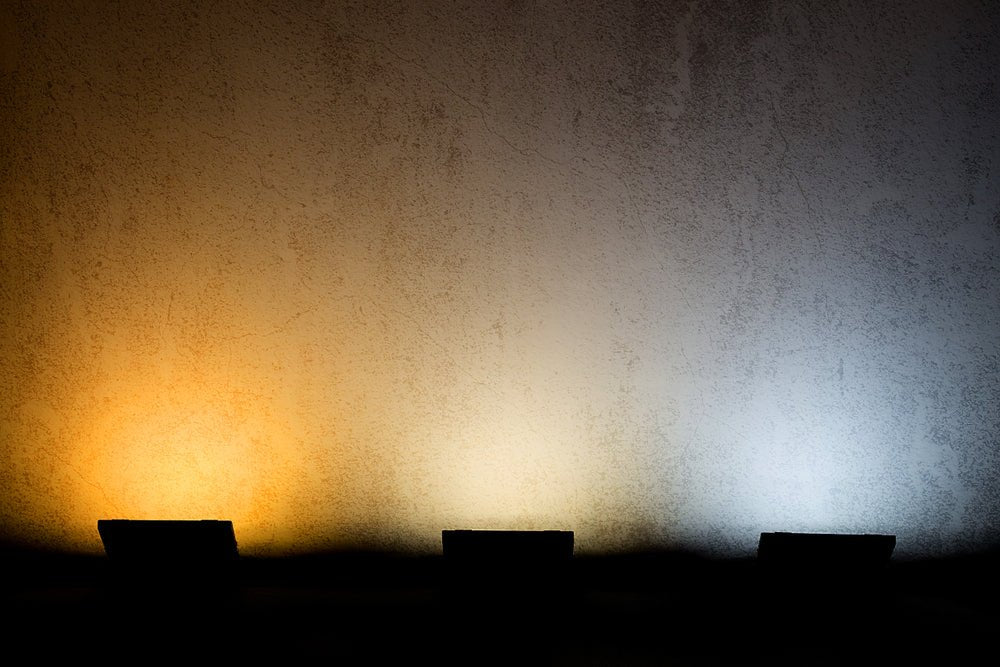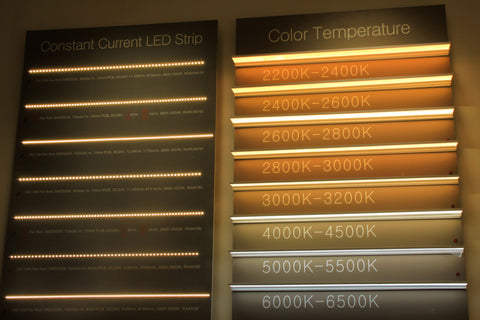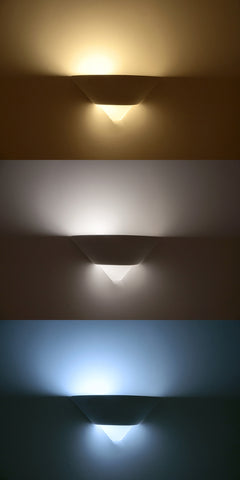
CCT stands for Correlated colour Temperature, and it is a specification used to describe the colour appearance of light emitted by a light source. It is measured in Kelvin (K). The CCT value indicates whether the light appears warm or cool in colour.
The Kelvin scale is a temperature scale where lower values represent warmer colours (such as yellow and red) and higher values represent cooler colours (such as blue and white). In the context of lighting, CCT is used to describe the colour appearance of white light, particularly for LED lights.
Common CCT values for lighting applications include:
- Warm White: CCT between 2700K and 3000K. It produces a warm, cosy, and yellowish light similar to traditional incandescent bulbs.
- Cool White: CCT between 3500K and 5000K. It produces a neutral, balanced light that is neither too warm nor too daylight.
-
Cool Daylight: CCT between 5000K and 6500K. It produces a bright, crisp, and cooler light similar to daylight.

CCT is an important consideration when selecting lighting for different applications as it can impact the ambiance, mood, and functionality of a space. The choice of CCT depends on personal preference, the desired lighting effect, and the specific application or environment where the lighting will be used.
What is The Meaning of CCT?
CCT stands for Correlated colour Temperature. It is a metric used to describe the colour appearance of light emitted by a light source. The CCT value is measured in Kelvin (K) and indicates whether the light appears warm or cool in colour.
The Kelvin scale is a temperature scale that relates to the colour of light. Lower CCT values represent warmer colours (such as yellow and red), while higher CCT values represent cooler colours (such as blue and white). CCT is commonly used to classify the colour appearance of white light sources.
For example, a light source with a CCT of 2700K is considered warm white, emitting a soft, yellowish light similar to traditional incandescent bulbs. A light source with a CCT of 4000K - 5000K is considered cool white, emitting a bright, bluish-white light similar to daylight.
Understanding the CCT of a light source can help in selecting the desired lighting effect, creating a specific ambiance, or matching the lighting to the task or environment.
What Is the History of CCT?
The concept of Correlated Colour Temperature (CCT) has its roots in the field of colourimetry, which is the science of measuring and quantifying colour. The development of CCT as a metric for describing the colour appearance of light sources can be attributed to the work of various researchers and organisations over time.
One key figure in the history of CCT is Wilhelm Wien, a German physicist who made significant contributions to understanding the thermal radiation of objects. In the late 19th century, Wien developed Wien's Displacement Law, which relates the peak wavelength of the radiation emitted by a black body radiator to its temperature. This laid the foundation for understanding the relationship between temperature and colour.
In the early 20th century, researchers continued to explore the connection between temperature and colour. Notably, the Commission Internationale de l'Éclairage (CIE), an international organisation responsible for standardising colour measurement and terminology, played a significant role in developing the concept of CCT. The CIE introduced a standardised colour space called the CIE 1931 XYZ colour space, which forms the basis for colour measurement and analysis.
Over time, advancements in lighting technology, particularly the introduction of electric lamps such as incandescent bulbs and fluorescent tubes, led to the need for a standardised method of describing the colour appearance of light sources. The CIE, along with other organisations and researchers, further refined the concept of CCT and established a standardised scale based on the colour temperature of a black body radiator.
Today, CCT is widely used in the lighting industry and is an essential parameter for selecting lighting products and achieving the desired lighting effect in various applications. It provides a standardised and objective way to describe the colour appearance of light sources, aiding in the communication and understanding of lighting specifications.
How Does CCT Work?
CCT, or Correlated Colour Temperature, is a measurement used to describe the colour appearance of light emitted by a light source. It is based on the principle that different temperatures of heated objects emit light with different colours.
CCT is determined by comparing the colour of a light source to the colour of a theoretical black body radiator when both are heated to the same temperature. The black body radiator is an idealised object that absorbs all incident light and emits radiation across the electromagnetic spectrum based on its temperature.
The measurement of CCT is typically done using a spectrophotometer, which analyses the spectral distribution of the light emitted by the source. The spectrophotometer measures the intensity of light at different wavelengths and calculates the colour temperature based on the spectral power distribution.
CCT is expressed in Kelvin (K), which is a unit of temperature. Lower CCT values represent warmer colours, such as yellow and red, while higher CCT values represent cooler colours, such as blue and white. For example, a CCT of 2700K is considered warm white, while a CCT of 5000K is considered cool white.
CCT is an important parameter in lighting design as it helps determine the perceived colour of light and its suitability for specific applications. Different CCT values can create different moods, ambiance, and visual effects in a space. For example, warm white light with a lower CCT may be preferred for creating a cosy and intimate atmosphere, while cool white light with a higher CCT may be suitable for task lighting or achieving a bright and energetic ambiance.
By understanding and selecting the appropriate CCT for a lighting application, one can achieve the desired colour appearance and lighting effect.
What does "CCT" Stand for?
CCT stands for "Correlated Colour Temperature." It is a measure of the colour appearance of light emitted by a light source, expressed in Kelvin (K). CCT indicates whether the light appears warm (yellowish) or cool (bluish) in colour.
Why Is CCT Important?
CCT, or Correlated Colour Temperature, is important in lighting because it helps determine the perceived colour of light and its suitability for specific applications. Here are a few reasons why CCT is important:
- Colour Perception: CCT influences how we perceive the colour of light. Lower CCT values, such as warm white (2700K-3000K), appear more yellow and red, resembling the warm glow of incandescent lighting. Higher CCT values, such as cool white (5000K-6500K), appear more blue and white, resembling daylight or cool fluorescent lighting. The colour temperature can impact the aesthetics, mood, and visual comfort of a space.
- Atmosphere and Ambiance: Different CCT values can create different atmospheres and ambiance in a room or environment. Warm white light with a lower CCT can create a cosy and inviting atmosphere, suitable for residential spaces, restaurants, or hospitality settings. Cool white light with a higher CCT can create a more energising and focused ambiance, suitable for offices, retail spaces, or task-oriented areas.
- Task Performance: The appropriate CCT can enhance visibility and visual acuity for specific tasks. For example, a higher CCT in the cool white range is often preferred for tasks that require attention to detail, such as reading, studying, or precision work. Cooler colour temperatures can provide better visual contrast and reduce eye strain in these scenarios.
- Lighting Design and Integration: CCT is a critical parameter for lighting designers and architects to achieve desired lighting effects. By selecting the right CCT, they can create a cohesive lighting design that complements the space's overall aesthetics, enhances architectural features, and meets specific functional requirements.
- Compatibility and Consistency: CCT allows for the selection of compatible lighting products and ensures consistency in lighting across different fixtures and installations. For instance, in commercial or hospitality settings where multiple light sources are used, maintaining consistent CCT helps create a unified lighting scheme throughout the space.
What is CCT in LED Lighting?
CCT in LED lighting refers to Correlated colour Temperature. It is a specification that describes the colour appearance of light emitted by an LED light source. CCT is measured in Kelvin (K) and indicates whether the light appears warm or cool.
In LED lighting, CCT is used to classify the colour temperature of the emitted light. Lower CCT values, such as 2700K-3000K, are considered warm white and have a yellowish or reddish hue resembling traditional incandescent lighting. Higher CCT values, such as 5000K-6500K, are considered cool white and have a bluish or whitish hue resembling daylight or cool fluorescent lighting.
The choice of CCT in LED lighting depends on the intended application and desired ambiance. For example, warm white light with a lower CCT is often used in residential spaces, hospitality settings, or areas where a cosy and relaxing atmosphere is desired. Cool white light with a higher CCT is commonly used in commercial spaces, offices, or task-oriented areas where bright and focused illumination is needed.
CCT in LED lighting provides flexibility and allows users to select lighting solutions that meet their specific needs in terms of colour appearance, mood, and functionality.
What Is The Difference Between CT and CCT?
CT and CCT are both related to the colour temperature of light, but they have slightly different meanings:
- CT: CT stands for "Colour Temperature." It is a measurement of the colour appearance of light, typically expressed in Kelvin (K). CT indicates whether the light appears warm or cool. A lower CT value indicates a warmer (more yellowish or reddish) light, while a higher CT value indicates a cooler (more bluish or whitish) light. CT is a general term used to describe the colour temperature of any light source, including both natural and artificial lighting.
- CCT: CCT stands for "Correlated Colour Temperature." It is a specification specifically used for artificial light sources, such as LED lights. CCT measures the colour appearance of light emitted by an LED light source. It is also expressed in Kelvin (K) and indicates whether the light appears warm or cool. The difference between CT and CCT is that CCT is specifically used for artificial light sources like LEDs, while CT is a more general term that can refer to the colour temperature of any light source, including natural light.
What is the Difference Between RGB and CCT?
RGB and CCT are two different colour control systems used in lighting, and they have distinct characteristics:
RGB: RGB stands for "Red, Green, Blue." It is a colour control system that uses three primary colours (red, green, and blue) to create a wide range of colours. RGB lighting fixtures have individual red, green, and blue LEDs that can be combined in different intensities to produce various colours. By adjusting the intensity of each colour, RGB lights can create vibrant and dynamic colour-changing effects. RGB lighting is commonly used for decorative and ambient lighting purposes, allowing for creative colour displays and customisation.
CCT: CCT stands for "Correlated colour Temperature." It is a specification that describes the colour appearance of white light emitted by a light source. CCT is measured in Kelvin (K) and represents the warmth or coolness of the light. It ranges from warm white (lower CCT values, typically around 2700K-3000K) to cool white (higher CCT values, typically around 5000K-6500K). CCT control allows for adjusting the colour temperature of white light to create different lighting atmospheres and mimic natural daylight.
What is Difference Between CRI and CCT?
CRI (Colour Rendering Index) and CCT (Correlated Colour Temperature) are both important factors in assessing the quality of light, but they measure different aspects:
CCT (Correlated Colour Temperature): CCT refers to the colour appearance of light and is measured in Kelvin (K). It indicates whether the light appears warm or cool. A lower CCT value (e.g., 2700K) indicates a warmer, more yellowish light, while a higher CCT value (e.g., 5000K) indicates a cooler, more bluish light. CCT helps in determining the overall colour tone of the light source.
CRI (Colour Rendering Index): CRI measures how accurately a light source can render colours compared to a reference light source of the same CCT. It is expressed as a number on a scale of 0 to 100. A higher CRI indicates that the light source accurately represents colours, while a lower CRI means that colours may appear distorted or less vibrant. CRI is particularly important in applications where accurate colour representation is crucial, such as in retail, photography, or artwork displays.
How is CCT Measured?
CCT (Correlated colour Temperature) is measured using a colour temperature meter or spectrometer. Here's a general overview of how CCT is typically measured:
- Spectral Power Distribution: The light source's spectral power distribution is first measured, which provides information about the intensity of light at different wavelengths.
- Calculation of Chromaticity Coordinates: The measured spectral data is used to calculate the chromaticity coordinates of the light source. Chromaticity coordinates are two values (x, y or u', v') that represent the position of the light source on the CIE chromaticity diagram.
- Calculation of CCT: The chromaticity coordinates are then used to determine the CCT value. This is done by comparing the coordinates to the black body locus, which represents the colour temperature of a theoretical black body radiator. The distance between the measured chromaticity coordinates and the black body locus determines the CCT.
- Reporting the CCT Value: The calculated CCT value is reported in Kelvin (K). It indicates whether the light appears warm (lower CCT) or cool (higher CCT).
It's important to note that specialised equipment and expertise are required to accurately measure CCT. The process may vary slightly depending on the specific measurement device and methodology used.
What is Normal CCT?
The term "normal CCT" is not a standardised or widely used term in the context of correlated colour temperature (CCT). CCT refers to the perceived colour of light emitted by a light source, and it is measured in Kelvin (K). Different CCT values represent different colour appearances, ranging from warm tones (lower CCT values) to cool tones (higher CCT values).
Typically, CCT values can be categorised as follows:
- Warm White: CCT around 2700K to 3000K. It emits a warm, yellowish-white light similar to traditional incandescent bulbs.
- Neutral White(Cool White): CCT around 3500K to 5000K. It emits a neutral, slightly cool white light often used in commercial and office spaces.
- Daylight: CCT around 5000K to 6000K. It emits a bright, cool white light similar to natural daylight.
-
Cool Daylight or Daylight White: CCT around 6000K to 6500K or higher. It emits a bluish-white light resembling bright daylight.

The specific CCT considered "normal" can vary depending on the application, personal preference, and the desired lighting environment. For residential lighting, CCT values in the range of 2700K to 4000K are commonly used, while commercial and outdoor applications may utilise higher CCT values for increased brightness and visibility.
What is The Best CCT for Lighting?
The best CCT (correlated colour temperature) for lighting depends on several factors, including the specific application, the desired ambiance, and personal preference. Here are some general guidelines:
- Warm White (2700K-3000K): Warm white light creates a cosy and intimate atmosphere. It's commonly used in residential spaces, such as living rooms, bedrooms, and dining areas, as well as in hospitality settings.
- Cool White (3500K-5000K): Neutral white(cool white) light provides a balanced and natural appearance. It's suitable for commercial spaces, offices, retail stores, and areas where tasks require good colour accuracy.
- Daylight (5000K-6000K): Daylight produces a bright and energetic ambiance. It's often used in task-oriented environments, such as offices, workshops, hospitals, and retail spaces, where visual acuity and clarity are important.
- Cool Daylight White (6000K and above): Cool Daylight white light mimics natural daylight and offers excellent colour rendering. It's suitable for applications where accurate colour representation is crucial, such as art galleries, showrooms, photography studios, and surgical rooms.
It's worth noting that personal preferences can vary, and different lighting scenarios may require different CCTs. Consider the function of the space, the mood you want to create, and any specific requirements for colour accuracy when choosing the best CCT for your lighting needs.
What is The CCT Range for Daylight?
The CCT (correlated colour temperature) range for daylight is typically considered to be between 5000K and 6500K. Daylight is often associated with a colour temperature of around 5500K, which represents the midday sun or a clear sky. This colour temperature is characterised by a cool, bluish-white light that is similar to natural daylight. It provides a bright and energising illumination that is suitable for tasks requiring good colour accuracy and visual clarity. Daylight CCTs are commonly used in spaces such as offices, retail stores, showrooms, photography studios, and other environments where accurate colour representation is important.
Does CCT Affect Lumens?
CCT (correlated colour temperature) does not directly affect lumens.
CCT refers to the colour appearance of light, specifically the perceived "warmth" or "coolness" of the light emitted by a light source. It is measured in Kelvin (K). A lower CCT value, such as 2700K, represents a warmer or more yellowish light, while a higher CCT value, such as 5000K, represents a cooler or bluish-white light.
On the other hand, lumens measure the brightness or intensity of light emitted by a source. It quantifies the total amount of visible light emitted, regardless of the colour temperature.
While CCT and lumens are related to the quality and quantity of light, they are independent of each other. A light source can have the same lumen output across different CCTs. For example, a 1000-lumen LED bulb can be available in both warm white (2700K) and cool white (5000K) options.
It's important to note that the perceived brightness of light can be influenced by the CCT. Cooler colour temperatures (higher Kelvin values) tend to appear brighter, while warmer colour temperatures (lower Kelvin values) may appear softer or dimmer. However, this is a perceptual effect and not a direct relationship between CCT and lumens.



